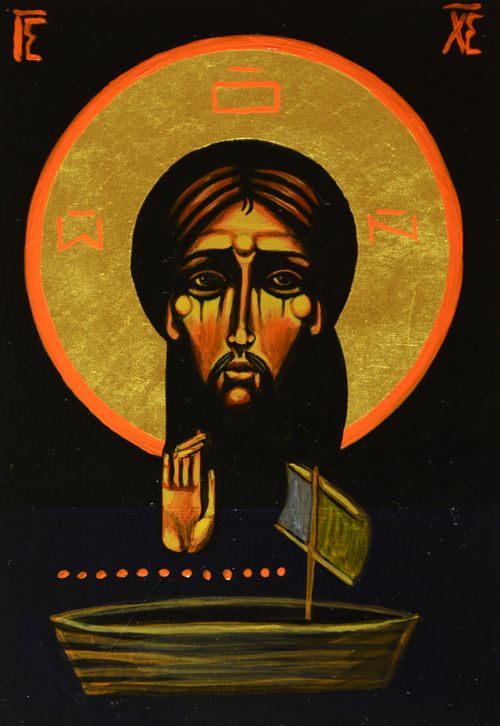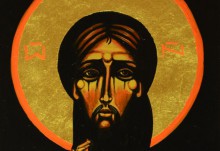Hubert Kampa is interested in theology and paints icons; being a native Pole, he supports Ukrainians with all his heart and soul. He is currently helping our soldiers and volunteering for Eleos-Ukraine, a faith-based NGO sponsored by the Ukrainian Orthodox Church – Kyiv Patriarchate (UOC-KP)’s Synodal Department of Social Service and Charity. Incidentally, Patriarch of Kyiv and All Rus’-Ukraine Filaret awarded the medal For Sacrifice and Love for Ukraine to the icon painter. We talked to Kampa about his discovery of the Euromaidan events and the war in the east as well as charity and spirituality in the icon.
How did it happen that you joined Eleos-Ukraine’s initiatives and learned about these plein air projects?
“I came to Ukraine for the first time four years ago for an international icon-painting plein air which, by the way, was organized by Lviv artists in Zamlynnia, Volyn. I represented the Polish side. It was a bit shocking experience for me since my first visit to Ukraine saw me going to Volyn at once. You know how hotly debated the past of this region is among the Poles. However, it was during that event that I was able to get to know your country, to meet with people who told me more about events that happened here. It was followed by a plein air hosted in Nowica, Poland, and later on we went to Zamlynnia again, and that was where I met Father Serhii Dmitriiev for the first time [Father Serhii is deputy head of the UOC-KP’s Synodal Department of Social Service and Charity, executive secretary of the Commission for Social Service of the All-Ukrainian Council of Churches and Religious Organizations, and director of Eleos-Ukraine. – Author]. Incidentally, it coincided with the Boeing 777 disaster and final events of the Euromaidan. After the plein air ended, I went to Kyiv to visit a friend of mine, and Father Serhii offered me a ride. We discussed projects and initiatives on the way. I had known something about the Euromaidan, but my knowledge had been incomplete. While talking with Father Serhii, an idea occurred to us to organize the next plein air, which would be a form of gratitude for what Ukraine did in this difficult time, as the first anniversary of the Euromaidan was approaching then. We organized such a plein air at Kyiv’s St. Michael’s Cathedral and invited artists from different countries. Independence Square was not completely cleared yet, there were some barricades still standing, and I wondered a lot what to paint. Frankly, I was unable to create anything for the first three days of the event. Then I saw at an exhibition a copy of the Scripture brought from Savur-Mohyla. It is probable that a Ukrainian soldier held the book immediately before his death. It was a shock for me as a Pole because we in Poland do not get enough information. The book of the Scripture was opened, and I read the text: it was the story of Jesus Christ who came to his disciples during a storm and told them not to be afraid. I painted a little icon of this scene then. Father Serhii later offered to go with him to meet soldiers serving in eastern Ukraine. I agreed, and we held a plein air near Melitopol, visiting the 30th Brigade’s positions. What I saw there shocked me as well. On the one hand, they lacked basics, like food, hygiene items, and everything else. On the other, I found there people with open and warm hearts, capable of self-sacrifice. In other countries, military service is a profession, and people go to war as if it was a regular job, while Ukrainian soldiers fight for their beliefs, and they are also very young, almost children. I made personal acquaintance with many of them. After seeing firsthand what was happening in Ukraine, I decided to volunteer for Eleos-Ukraine.”
You participated in the Charity in the Icon plein air. How important was this initiative’s influence on the developments in Ukraine?
“The main idea of that event was to get the icons painted during the plein air to military hospitals as a form of gratitude for their patients’ pains and sufferings. Each of the artists found for themselves a saint who exemplified charity, some painted the Holy Virgin. Combined, all these icons formed a kind of exhibition. I and Father Serhii visited Ukrainian soldiers in the east on Christmas 2014, and then decided to show this prayer-in-icon in Poland, displaying these artworks at local churches. Totally intentionally, we called the exhibition ‘The Prayer for Ukraine.’ The first display of the icons was held in Warsaw on the first anniversary of the Black Thursday tragedy [February 20, 2014 massacre in Kyiv. – Ed.]. We were surprised to see about 1,000 visitors, so that the church was packed full. We prayed together for God’s mercy with the clergy of the UOC-KP. It was an extremely powerful prayer. The exhibition toured other cities then, including Opole. Before the opening of the event, I realized that it was this city where many Poles who had been expelled from Ukraine lived. I remember that when I was putting up a banner of this exhibition, inscribed with the words ‘The Prayer for Ukraine,’ I was approached by a gentleman who said: ‘I have no duty to pray for Ukraine!’ Later, during the exhibition, I saw a lady standing before the icons and crying. I walked over and asked what had happened. She replied that she had been brought up in a family of expellees who taught her to hate Ukraine. However, our event revealed truth. She saw now that Ukrainians were not as bad as she had been taught, but rather a suffering people in need of care. This case was not unique either. A lot of people changed their views after the exhibition of our icons.”
You took part in another plein air in the summer of 2015. Was it a continuation event?
“Yes, we engaged once again in painting charity in the icon, but based on the texts of the Old Testament this time. I would like to say that it is not easy. But we had a good opportunity to develop ourselves spiritually by seeking new interpretations. We later met in Kyiv and worked on the ways to reflect the emigration issues in the icon, using the texts of the Scripture again. The exhibition was housed in the Metropolitan’s Mansion at St. Sophia Cathedral, Kyiv. We donated a few icons to hospitals in Poland recently, and even organized special concerts there. For example, a choir from Rivne performed in Lublin. Again, these events were educational as well, because we Poles get immersed in our own issues and thus forget the Euromaidan. And then, some people come from Ukraine with icons and offer thanks for our prayers! It was very important – to show that Ukrainians do not only accept our help, but give back as well. By the way, the news of our event even made it to national TV channels in Poland.”

A few weeks ago, you also donated a few icons to the Lviv Military Hospital. Are icons coming back to medical institutions a kind of symbol as well?
“Yes, of course. Firstly, it is a symbol of unity, primarily with the people who are now serving on the frontlines. Secondly, it is a metaphor for faith, because through this prayer, which is reflected in the icon, no one is left abandoned and forgotten.”
How do you, as an icon painter, define charity in the icon?
“No human is unquestionably charity-minded, because we, especially in today’s world, see renouncing our own interests and self-sacrificing for another person as too much trouble. The best example of charity is God alone, and we can take Him as an example using the Scripture as our guide. For me personally, charity is a representation of dialog, when I try to listen to the other and not speak in a monolog, when I abandon my own stereotypes. We have to tell the truth. Dialog and charity are a desire to open oneself to another person, even if one has been personally injured by the other, as exemplified by the image of Volyn in the minds of Poles which I mentioned before.”
What other initiatives are you planning together with Eleos-Ukraine?
“We plan to organize a joint plein air in Jerusalem. We want to select not only good, technically proficient icon painters, but also people who experience their work as spiritual effort, who are believers. Also, we will select artists who had struggled with some addiction, like drugs or alcohol. Icon painters will mutually support each other, because the theme of the plein air is the Transfiguration of the Lord. The main idea of the event is a renewal of normal life, an understanding that even if one takes a wrong path, there is always a chance to return. We will later gather in Kyiv again, as we do so every year to honor the memory of the Euromaidan events.”









